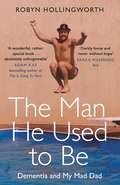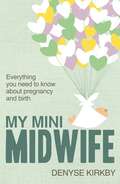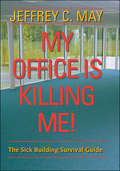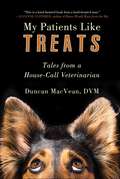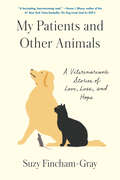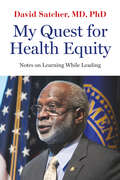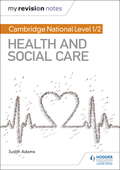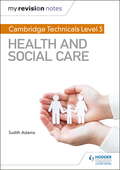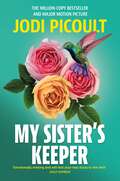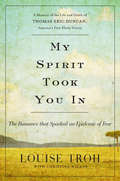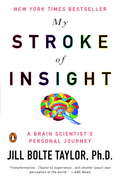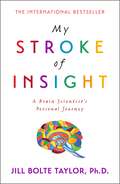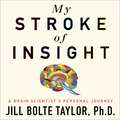- Table View
- List View
My Lovely Wife in the Psych Ward: A Memoir
by Mark LukachA heart-wrenching, yet hopeful, memoir of a young marriage that is redefined by mental illness and affirms the power of love.Mark and Giulia’s life together began as a storybook romance. They fell in love at eighteen, married at twenty-four, and were living their dream life in San Francisco. When Giulia was twenty-seven, she suffered a terrifying and unexpected psychotic break that landed her in the psych ward for nearly a month. One day she was vibrant and well-adjusted; the next she was delusional and suicidal, convinced that her loved ones were not safe. Eventually, Giulia fully recovered, and the couple had a son. But, soon after Jonas was born, Giulia had another breakdown, and then a third a few years after that. Pushed to the edge of the abyss, everything the couple had once taken for granted was upended. A story of the fragility of the mind, and the tenacity of the human spirit, My Lovely Wife in the Psych Ward is, above all, a love story that raises profound questions: How do we care for the people we love? What and who do we live for? Breathtaking in its candor, radiant with compassion, and written with dazzling lyricism, Lukach’s is an intensely personal odyssey through the harrowing years of his wife’s mental illness, anchored by an abiding devotion to family that will affirm readers’ faith in the power of love.
My Mad Dad: The Diary of an Unravelling Mind
by Robyn HollingworthInadvertent cross-dressing Attempted murder Jail break A waltz at a funeral A hernia the size of GuernseyHeartbreaking and darkly comic, these are the moments that litter the messy road from cared-for to carer, a journey that Robyn Hollingworth finds herself on when she's only twenty-five years old. Leaving London to return home to rural South Wales, Robyn finds that it's her old life - same teddy bears resting on her pillow, their bodies tucked under the duvet; same view of the garages behind which she'd had her first cigarette and first kiss - but so much has changed. Her dad, the proud, charmingly intelligent, self-made man who made people laugh, is in the grip of early onset Alzheimer's. His brilliant mind, which saw him building power stations and literally bringing light into the lives of others, has succumbed to darkness. As Robyn settles back in the rhythms of life in the rain-soaked vast Welsh valleys, she keeps a diary charting her journey as the dad she knew disappears before her eyes. Lyrical, poignant and with flashes of brilliant humour, My Mad Dad explores how in helping others we can heal ourselves. 'At some point the cared for become the carers...this isn't a shame and it isn't a tragedy and it isn't a chore. It is an honour. To be able to return the gift of love that someone bestows upon you is a gift in itself. This is a story of caring...'
My Madness Saved Me: The Madness and Marriage of Virginia Woolf
by Thomas Szasz"The vast literature on Virginia Woolf's life, work, and marriage falls into two groups. A large majority is certain that she was mentally ill, and a small minority is equally certain that she was not mentally ill but was misdiagnosed by psychiatrists. In this daring exploration of Woolf's life and work, Thomas Szasz--famed for his radical critique of psychiatric concepts, coercions, and excuses--examines the evidence and rejects both views. Instead, he looks at how Virginia Woolf, as well as her husband Leonard, used the concept of madness and the profession of psychiatry to manage and manipulate their own and each other's lives.Do we explain achievement when we attribute it to the fictitious entity we call ""genius""? Do we explain failure when we attribute it to the fictitious entity we call ""madness""? Or do we deceive ourselves the same way that the person deceives himself when he attributes the easy ignition of hydrogen to its being ""flammable""? Szasz interprets Virginia Woolf's life and work as expressions of her character, and her character as the ""product"" of her free will. He offers this view as a corrective against the prevailing, ostensibly scientific view that attributes both her ""madness"" and her ""genius"" to biological-genetic causes. We tend to attribute exceptional achievement to genius, and exceptional failure to madness. Both, says Szasz, are fictitious entities."
My Mini Midwife: Everything You Need to Know about Pregnancy and Birth
by Denyse KirkbyEver wished your midwife lived next door so you could ask her questions anytime? My Mini Midwife, by midwife and lecturer D. J. Kirkby, is here to provide the guidance you need. This handy book gives clear answers to confusing questions, from conception to delivery and beyond: it will be invaluable for anyone who is planning or expecting a baby.
My Mini Midwife: Everything You Need to Know about Pregnancy and Birth
by Denyse KirkbyEver wished your midwife lived next door so you could ask her questions anytime? My Mini Midwife, by midwife and lecturer D. J. Kirkby, is here to provide the guidance you need. This handy book gives clear answers to confusing questions, from conception to delivery and beyond: it will be invaluable for anyone who is planning or expecting a baby.
My Name Is Bill: Bill Wilson--His Life and the Creation of Alcoholics Anonymous
by Susan CheeverIn this thoroughly researched and groundbreaking biography of Bill Wilson, cofounder of Alcoholics Anonymous, acclaimed author Susan Cheever creates a remarkably human portrait of a man whose life and work both influenced and saved the lives of millions of people. Drawn from personal letters and diaries, records in a variety of archives, and hundreds of interviews, this definitive biography is the first fully documented account of Bill Wilson's life story.Alcoholics Anonymous is a worldwide organization that since 1935 has helped people break free from the destructive influence of intoxicating and addictive substances. This great wave of comfort and help that has covered the world had its beginning in one man, born shortly before the start of the twentieth century. Utilizing exhaustive research, Cheever traces Bill Wilson's life beginning with his birth in a small town in Vermont, where, following the breakup of his parents' marriage, he was raised primarily by his grandparents. Handsome and intelligent, with a wit and charm that both women and men responded to, he seemed at the outset to be capable of achieving anything he wanted.Wilson, however, also suffered from deep-seated insecurity, and once he was away from the provincial Vermont town, he found that alcohol helped relieve his self-doubts and brought out the charm and wit that had made him a favorite in school. "Help" eventually turned to dependence, and years after his first beer -- consumed at a Newport, Rhode Island, dinner party -- Bill Wilson finally had to come to terms with the fact that, while he loved the way alcohol made him feel, his life was spiraling out of control. Through a painful process of trial and error, using a blend of experiences, ideas, and medical knowledge gained through several hospitalizations, he was able to stop drinking. A few months later, when he met Dr. Robert Smith of Akron, Ohio, and was able to help him stop drinking also, Alcoholics Anonymous was born. Each man found in the other the support he needed to overcome the hold alcohol had on them. Together they discovered the power they had to help other alcoholics.Success did not come overnight, however, and as Cheever compellingly relates, Wilson had many struggles in a life fraught with controversies, including experiments with LSD and an unconventional fifty-three-year marriage.As one of the most influential and important thinkers of the twentieth century, Bill Wilson changed the way our society deals with addiction, and his ideas in turn have benefited countless individuals and their families. His life was complex, and in Susan Cheever's fascinating biography, he emerges as a man of great passion and courage; it is a story fully told for the first time.
My Office Is Killing Me!: The Sick Building Survival Guide
by Jeffrey C. MayBacteria and mold may lurk undetected in carpets or in the heating or cooling system of your office or school. When inhaled, the by-products of these organisms can cause allergy and asthma symptoms. Chemical vapors emitted by office furniture and equipment may also foul the air we breathe indoors, causing headaches, eye irritation, or other symptoms. Here the author of the best-selling My House Is Killing Me! and co-author of The Mold Survival Guide turns his attention to indoor air quality in public buildings. Blending his extensive professional experience with scientific explanations, May helps us see these buildings through the eyes of a building scientist, microscopist, and organic chemist. He offers a step-by-step approach to identifying, controlling, and often eliminating the sources of indoor air pollutants and allergens. Whether it's a case of mold in an elementary school or inadequate ventilation in a high-rise office building, this valuable guide can help people cope when the air they breathe indoors is making them sick.
My Parent's Keeper: The Guilt, Grief, Guesswork, and Unexpected Gifts of Caregiving (Yale University Press Health & Wellness)
by Jody Gastfriend&“Unflinchingly tackles a complex aspect of eldercare in each chapter . . . an indispensable resource for family caregivers.&”—Patrick O&’Malley, author of Getting Grief Right When it comes time to provide care for those who once cared for us, where can we turn? This book offers practical guidance for a broad range of caregiving situations when family caregivers assume their new role. My Parent&’s Keeper . . . · Uses the latest research and draws on case histories and interviews. · Is a resource as well as a source of inspiration, with a blend of powerful stories and practical advice. · Helps caregivers cope with numerous challenges, including parents who need but refuse help; siblings who don&’t get along; the complexity of healthcare systems; financial issues; juggling work and caregiving; the use of technology; the power of connecting with a loved one who has dementia; and realizing the benefits amid the burdens of caregiving. &“Jody Gastfriend has created the ultimate GPS for family caregivers. At once humane and helpful, personal and political, she charts the long, hard, and rewarding role that all of us will take caring for our families and each other. Don&’t leave home without it!&”—Ellen Goodman, Pulitzer Prize-winning columnist and founder of The Conversation Project &“My Parent's Keeper shines a light on the conundrum of caregiving—as adult children, our best intentions are insufficient to help our parents and ourselves. We need a plan in advance of need—this book offers up-to-date guideposts for this inevitable caregiving journey.&”—Laurie M. Orlov, author of When Your Parents Need Elder Care: Lessons from the Front Lines
My Path Leads to Tibet: The Inspiring Story of How One Young Blind Woman Brought Hope to the Blind Children of Tibet
by Sabriye TenberkenDefying everyone's advice, armed only with her rudimentary knowledge of Chinese and Tibetan, Sabriye Tenberken set out to do something about the appalling condition of the Tibetan blind, who she learned had been abandoned by society and left to die. Traveling on horseback throughout the country, she sought them out, devised a Braille alphabet in Tibetan, equipped her charges with canes for the first time, and set up a school for the blind. Her efforts were crowned with such success that hundreds of young blind Tibetans, instilled with a newfound pride and an education, have now become self-supporting. A tale that will leave no reader unmoved, it demonstrates anew the power of the positive spirit to overcome the most daunting odds.
My Patients Like Treats: Tales from a House-Call Veterinarian
by Duncan MacVeanIt’s all fun and games until somebody ends up in a cone. Physicians used to make house calls. Today, a few veterinarians still do. Duncan MacVean, DVM, is one such vet. His patients range from cats and dogs to pigs and lizards—each of them a unique personality. Every animal and every home is different, but every owner is the same in their affection for their companions. Without warning, MacVean finds himself in odd situations: stepping into a basement full of free-flying bats or struck speechless by a pig who loves opera so much that she falls into a trance. The hilarious and the heartbreaking come together in this collection of true tales, all gathered from his lifelong career. MacVean finds himself riding backwards atop a potbelly pig that bucks and kicks its way down the hall, knocking over a china cabinet in the process. One woman with terminal cancer earnestly wants to know where pets go when they pass away—will her beloved cat and dog join her in the afterlife? Navigating the finer elements of human and animal interaction isn’t easy. Here, MacVean provides a glimpse into his experience with such relationships, always looking for the humor and light of every situation. With never a dull moment, his dedication to the animals of this earth and compassion for their human caretakers drives MacVean onward, from house to house, from patient to patient. This heartwarming collection of stories brings readers along for the ride, getting to know the curious creatures he treats and their perhaps sometimes even more curious humans. My Patients Like Treats is the perfect book for animal lovers or those who simply appreciate a good story.
My Patients and Other Animals: A Veterinarian's Stories of Love, Loss, and Hope
by Suzy Fincham-GrayA moving memoir of a life spent in the company of animals—a veterinarian sheds light on the universal experience of loving, healing, and losing our beloved pets, and the many ways they change our lives. The pursuit of a childhood dream has taken Suzy Fincham-Gray on a journey in veterinary medicine from pastoral farms on the English–Welsh border to emergency rooms in urban American animal hospitals, with thousands of stories collected along the way. In this unforgettable literary debut, she writes about some of the most emotionally challenging and rewarding cases of her career. Like many physicians, Fincham-Gray tends to see her patients at often life-or-death moments. While dramatic, these stories expand into deeper explorations of our complex, profound relationships with the animals in our lives. She describes the satisfaction of diagnosing and treating difficult diseases and the universal experience of loving a pet, and—inevitably—raises questions about their end-of-life care. We meet Grayling, an Irish wolfhound in need of critical treatment; we learn about the fulfillment of caring for a chronically ill pet from the story of Zeke, a silver-brown tabby cat who likes to eat just a little too much; and we fall in love with Monty and Emma, Fincham-Gray’s own adopted cat and dog, who change her life in joyful and unexpected ways. Fincham-Gray depicts the sleepless nights she spends waiting for her pager to call her to the clinic, the cutthroat competition among residents, and what it’s really like to care for patients who can’t advocate for themselves. Warm and humorous, Suzy Fincham-Gray is a rare breed—a clinician with an intimate, elegant literary style. She writes with the same tenderness she brings to her patients, whose needs she must meet with her mind, her hands, and her heart. “Suzy Fincham-Gray gives readers rare insight into the making of a compassionate doctor. Her passion for both science and the animals she cares for, combined with her eloquence as a writer, made me want Suzy as both my dogs’ veterinarian and my own friend.”—Teresa J. Rhyne, author of the #1 New York Times bestseller The Dog Lived (and So Will I)
My Pet Virus
by Shawn DeckerIwas destined for a life of medical drama from day one," begins this comic memoir with a mission. "I was born in the month of July, and my horoscope sign is a disease (Cancer). The symbol for Cancer? A crab (the sexually transmitted critter). Not only that, my parents named me Shawn Timothy Decker, which makes my initials S. T. D. Shawn Decker isn't quite the All-American boy. Sure, he gets caught shoplifting copies of Penthouse; is crazy about prowrestling, especially "The Nature Boy" Ric Flair; and never has a problem getting dates. But he's also a hemophiliac who discovers, at age eleven, that he has contracted HIV from tainted blood products. Instead of becoming self-pitying and dying (as first predicted), Shawn develops a twisted sense of humor, meets Depeche Mode through the Make-A-Wish Foundation, and writes on blogs and in Poz magazine about what it's like being hetero and HIV-positive in rural Virginia. He also turns to gay men for advice on dating women and, almost twenty years after getting HIV, marries Gwenn Barringer, who is HIV-negative and a former competitor for the title of Miss Virginia. Together Shawn and Gwenn travel the country, speaking to high school and college kids about how to live and love with HIV (and how to avoid getting it). .
My Quest for Health Equity: Notes on Learning While Leading (Health Equity in America)
by David SatcherReading this book is like sitting down with Dr. David Satcher to hear stories of leadership and lessons learned from his lifetime commitment to health equity.Dr. David Satcher is one of the most widely known and well-regarded physicians of our time. A former four-star admiral in the US Public Health Service Commissioned Corps, he served as the assistant secretary for health, the surgeon general of the United States, and the director of the Centers for Disease Control and Prevention before founding the eponymous Satcher Health Leadership Institute at Morehouse School of Medicine. At the core of his impact on public health, he is also a lifelong leader for civil rights and health equity. Born black and poor in the deep South, Dr. Satcher was a victim of an unjust health care system: he almost died of whooping cough at the age of two because Jim Crow laws meant that his black doctor could not admit him to a hospital. That experience was the first of many that shaped him as a leader and a healer deeply attuned to social inequity—someone who was determined to make a positive difference.In My Quest for Health Equity, Dr. Satcher takes an inspiring and instructive look inside his fifty-year career to shed light on the challenge and burden of leadership. Explaining that he has thought of each leadership role—whether in academia, community, or government—as an opportunity to move the needle toward health equity, he shares the hard-won lessons he has learned over a lifetime in the medical field. Drawing on his early memories, medical school days, experience in the civil rights movement, and professional highs and lows, Dr. Satcher touches on a number of topics, including• the essential qualities of leadership• leading from science to policy to practice• the importance of clear communication and continual learning• the need for workplace discipline• confronting failure• specific health issues, including the obesity epidemic, reproductive health, and mental health stigma• team approaches to leadership• and much moreIn this book, readers will discover a template for using leadership roles of all types to eliminate health disparities. My Quest for Health Equity is a vital resource for current and rising leaders.
My Revision Notes: Cambridge National Level 1/2 Health And Social Care Epub
by Judith AdamsTarget success in Cambridge National Level 1/2 Child Development with this proven formula for effective, structured revision. Key content coverage is combined with exam-style tasks and practical tips to create a revision guide that students can rely on to review, strengthen and test their knowledgeWith My Revision Notes, every student can:- plan and manage a successful revision programme using the topic-by-topic planner- consolidate subject knowledge by working through clear and focused content coverage- test understanding and identify areas for improvement with regular 'Now Test Yourself' tasks and answers- improve exam technique through practice questions, expert tips and examples of typical mistakes to avoid.
My Revision Notes: Cambridge National Level 1/2 Health and Social Care
by Judith AdamsTarget success in Cambridge National Level 1/2 Health and Social Care with this proven formula for effective, structured revision. Key content coverage is combined with exam-style tasks and practical tips to create a revision guide that students can rely on to review, strengthen and test their knowledgeWith My Revision Notes, every student can:- plan and manage a successful revision programme using the topic-by-topic planner- consolidate subject knowledge by working through clear and focused content coverage- test understanding and identify areas for improvement with regular 'Now Test Yourself' tasks and answers- improve exam technique through practice questions, expert tips and examples of typical mistakes to avoid.
My Revision Notes: Cambridge Technicals Level 3 Health And Social Care Epub
by Judith AdamsEnhance your students' practical skills and develop their key content knowledge with this proven formula for effective, structured revision.Target success in OCR's Cambridge Technical Level 3 Health and Social Care with this revision guide that brings together exam-style questions, revision tasks and practical tips to help students to review, strengthen and test their knowledge.With My Revision Notes, every student can:- Enjoy an interactive approach to revision, with clear topic summaries that consolidate knowledge and related activities that put the content into context.- Plan and manage a successful revision programme using the topic-by-topic planner.- Build, practise and enhance exam skills by progressing through revision tasks and Test Yourself activities.- Improve exam technique through exam-style questions and sample answers with commentary from an expert author and teacher.- Get exam ready with answers to the activities available online
My Revision Notes: Cambridge Technicals Level 3 Health and Social Care
by Judith AdamsEnhance your students' practical skills and develop their key content knowledge with this proven formula for effective, structured revision.Target success in OCR's Cambridge Technical Level 3 Health and Social Care with this revision guide that brings together exam-style questions, revision tasks and practical tips to help students to review, strengthen and test their knowledge.With My Revision Notes, every student can:- Enjoy an interactive approach to revision, with clear topic summaries that consolidate knowledge and related activities that put the content into context.- Plan and manage a successful revision programme using the topic-by-topic planner.- Build, practise and enhance exam skills by progressing through revision tasks and Test Yourself activities.- Improve exam technique through exam-style questions and sample answers with commentary from an expert author and teacher.- Get exam ready with answers to the activities available online
My Second Life: Living with Parkinson's Disease
by William A. HarshawAt the age of 37, Bill Harshaw was diagnosed with Parkinson’s Disease. The news changed his life forever,bringing forth a saga that will give hope to not only Parkinsonians, but to people with chronic disease everywhere. My Second Life is not a detailed road map or a set of instructions. Instead, it is an account of his changing state of mind over the two decades that he has had Parkinson’s Disease.Beginning with his diagnosis at the age of 37, this twenty-year journey covers diagnosis, denial, coping with work, early retirement, experimental neurosurgery, and taking a major leadership role in The Parkinson Foundation of Canada. Bill’s account of the two neurosurgical procedures is the first by a patient of the operations that gave him a second chance at life."They say adversity draws out our deepest human qualities. To read Bill Harshaw’s story is to confirm that truth. From the scrap heap of neurogeneration at the same age as Michael J. Fox, to guinea pig for risky brain surgery and then to resurgence and rejoicing, Bill’s exemplary journey is a metaphor for the vast and positive capabilities of the human spirit." -David C. Simmonds, Chair, Parkinson Foundation of Canada
My Sister's Keeper
by Jodi PicoultTHE MILLION-COPY BESTSELLER AND MAJOR MOTION PICTURE'Emotionally riveting and will test your tear ducts to the limit' Daily ExpressIn all thirteen years of Anna's life, her parents have never given her a choice: she was born to be her sister Kate's bone marrow donor and she has always given Kate everything she needs.But when Anna is told Kate needs a new kidney, she begins to question how much she should be prepared to do to save the older sibling she has always been defined by. So Anna makes a decision that will change their family forever - perhaps even fatally for the sister she loves. From internationally bestselling author Jodi Picoult comes a masterpiece which asks us just how much we should do to care for the ones we love. THE BOOK OF TWO WAYS, Jodi's stunning new novel about life, death and missed opportunities is available to pre-order now.
My Spirit Took You In: The Romance that Sparked an Epidemic of Fear: A Memoir of the Life and Death of Thomas Eric Duncan, America's First Ebola Victim
by Christine Wicker Louise TrohLouise Troh--fiancée of Thomas Eric Duncan, the first man ever to die of Ebola in America--breaks her silence about her experience in this deeply moving memoir, chronicling the decade-long love story that starts in Liberia and ends in an isolation ward in Dallas, Texas.
My Stroke of Insight
by Jill Bolte TaylorOn the morning of the 10th December 1996, Jill Bolte Taylor, a thirty-seven-year-old Harvard-trained brain scientist experienced a massive stroke when a blood vessel exploded in the left side of her brain. A neuroanatomist by profession, she observed her own mind completely deteriorate to the point that she lost the ability to walk, talk, read, write, or recall any of her life, all within the space of four hours. As the damaged left side of her brain - the rational, logical, detail and time-oriented side - swung in an out of function, Taylor alternated between two distinct and opposite realities: the euphoric Nirvana of the intuitive and emotional right brain, in which she felt a sense of complete well-being and peace; and the logical left brain, that realized Jill was having a stroke and enabled her to seek help before she was lost completely. In My Stroke of Insight: A Brain Scientist's Personal Journey, Taylor brings to light a new perspective on the brain and its capacity for recovery that she gained through the intimate experience of awakening her own injured mind. The journey to recovery took eight years for Jill to feel completely healed. Using her knowledge of how the brain works, her respect for the cells composing her human form, and an amazing mother, Taylor completely repaired her mind and recalibrated her understanding of the world according to the insight gained from her right brain that December morning.
My Stroke of Insight
by Jill Bolte TaylorThe astonishing international bestseller that chronicles how a brain scientist's own stroke led to enlightenment.On the morning of the 10th December 1996, Jill Bolte Taylor, a thirty-seven-year-old Harvard-trained brain scientist experienced a massive stroke when a blood vessel exploded in the left side of her brain. A neuroanatomist by profession, she observed her own mind completely deteriorate to the point that she lost the ability to walk, talk, read, write, or recall any of her life, all within the space of four hours. As the damaged left side of her brain - the rational, logical, detail and time-oriented side - swung in an out of function, Taylor alternated between two distinct and opposite realities: the euphoric Nirvana of the intuitive and emotional right brain, in which she felt a sense of complete well-being and peace; and the logical left brain, that realized Jill was having a stroke and enabled her to seek help before she was lost completely. In My Stroke of Insight: A Brain Scientist's Personal Journey, Taylor brings to light a new perspective on the brain and its capacity for recovery that she gained through the intimate experience of awakening her own injured mind. The journey to recovery took eight years for Jill to feel completely healed. Using her knowledge of how the brain works, her respect for the cells composing her human form, and an amazing mother, Taylor completely repaired her mind and recalibrated her understanding of the world according to the insight gained from her right brain that December morning.
My Stroke of Insight
by Jill Bolte TaylorThe international bestseller and recommended by medics, patients and the NHS, this is a brain scientist's personal experience of a stroke. It tells of her journey and gives rare insight into human consciousness and its possibilities for all of us.On the morning of the 10th December 1996, Jill Bolte Taylor, a thirty-seven-year-old Harvard-trained brain scientist experienced a massive stroke when a blood vessel exploded in the left side of her brain. A neuroanatomist by profession, she observed her own mind completely deteriorate to the point that she lost the ability to walk, talk, read, write, or recall any of her life, all within the space of four hours. As the damaged left side of her brain - the rational, logical, detail and time-oriented side - swung in an out of function, Taylor alternated between two distinct and opposite realities: the euphoric Nirvana of the intuitive and emotional right brain, in which she felt a sense of complete well-being and peace; and the logical left brain, that realized Jill was having a stroke and enabled her to seek help before she was lost completely. In My Stroke of Insight: A Brain Scientist's Personal Journey, Taylor brings to light a new perspective on the brain and its capacity for recovery that she gained through the intimate experience of awakening her own injured mind. The journey to recovery took eight years for Jill to feel completely healed. Using her knowledge of how the brain works, her respect for the cells composing her human form, and an amazing mother, Taylor completely repaired her mind and recalibrated her understanding of the world according to the insight gained from her right brain that December morning.(P)2008 Penguin Audiobooks
My Stroke of Insight: A Brain Scientist's Personal Journey
by Jill Bolte TaylorThe astonishing New York Times bestseller that chronicles how a brain scientist's own stroke led to enlightenment On December 10, 1996, Jill Bolte Taylor, a thirty-seven- year-old Harvard-trained brain scientist experienced a massive stroke in the left hemisphere of her brain. As she observed her mind deteriorate to the point that she could not walk, talk, read, write, or recall any of her life-all within four hours-Taylor alternated between the euphoria of the intuitive and kinesthetic right brain, in which she felt a sense of complete well-being and peace, and the logical, sequential left brain, which recognized she was having a stroke and enabled her to seek help before she was completely lost. It would take her eight years to fully recover. For Taylor, her stroke was a blessing and a revelation. It taught her that by "stepping to the right" of our left brains, we can uncover feelings of well-being that are often sidelined by "brain chatter." Reaching wide audiences through her talk at the Technology, Entertainment, Design (TED) conference and her appearance on Oprah's online Soul Series, Taylor provides a valuable recovery guide for those touched by brain injury and an inspiring testimony that inner peace is accessible to anyone.
My Stroke of Insight: A Brain Scientist's Personal Journey
by Jill Bolte TaylorThe astonishing New York Times bestseller that chronicles how a brain scientist's own stroke led to enlightenment On December 10, 1996, Jill Bolte Taylor, a thirty-seven- year-old Harvard-trained brain scientist experienced a massive stroke in the left hemisphere of her brain. As she observed her mind deteriorate to the point that she could not walk, talk, read, write, or recall any of her life-all within four hours-Taylor alternated between the euphoria of the intuitive and kinesthetic right brain, in which she felt a sense of complete well-being and peace, and the logical, sequential left brain, which recognized she was having a stroke and enabled her to seek help before she was completely lost. It would take her eight years to fully recover. For Taylor, her stroke was a blessing and a revelation. It taught her that by "stepping to the right" of our left brains, we can uncover feelings of well-being that are often sidelined by "brain chatter." Reaching wide audiences through her talk at the Technology, Entertainment, Design (TED) conference and her appearance on Oprah's online Soul Series, Taylor provides a valuable recovery guide for those touched by brain injury and an inspiring testimony that inner peace is accessible to anyone.

